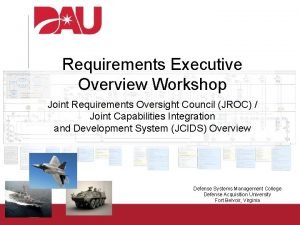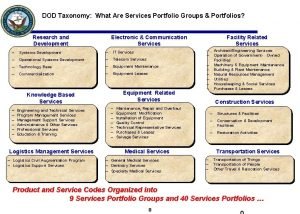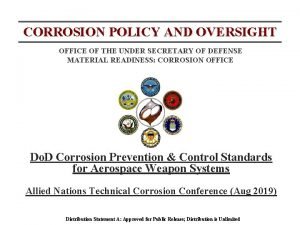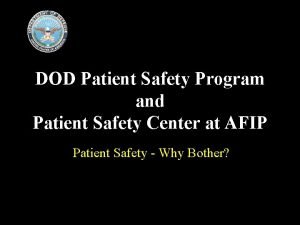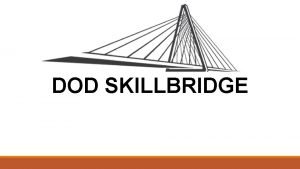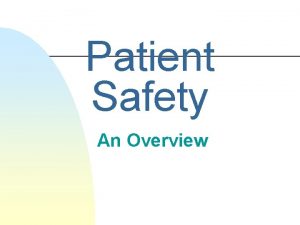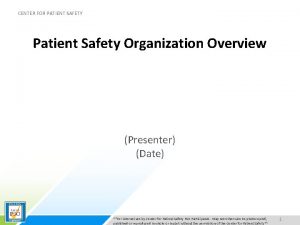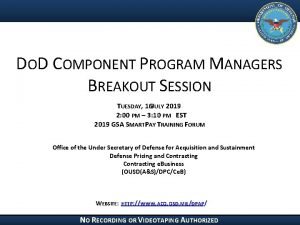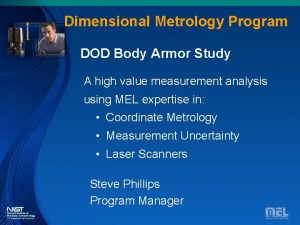DOD Patient Safety Program and Patient Safety Center













- Slides: 13

DOD Patient Safety Program and Patient Safety Center at AFIP Patient Safety - Why Bother?

Patient Safety Not a New Problem • 1964 - Schimmel (Ann. Int. Med. ) – 20% of Univ. Hospital Admissions Injured • 1981 - Steel (NEJM) – 36% of Teaching Hosp. Admissions Injured • 1989 - Gopher (Proc. Human Factors Society) – 1. 7 errors/day/patient (29% pot. serious) • 1991 - Harvard Practice Study (NEJM) – 4% of Admissions Injured NY State in 1984

National Center for Patient Safety • 1997 – National Patient Safety Partnership (NPSP) – Expert Advisory Panel on Patient Safety System Design • 1998 – NCPS Announced • 1999 - NCPS Formed

NCPS Expert Advisory Panel Recommendations Establish a Voluntary Reporting System – Confidential, De-identified, Non-punitive – Reports Should Emphasize Narratives – Interdisciplinary Review Teams – About Identifying Vulnerabilities NOT Statistics – Prompt Feedback – Open to All Comers

Quality Interagency Coordination Task Force (Qu. IC) • Established in 1998. • Chairs: Sec. of HHS & Depart. of Labor • Members: Departs of Commerce, Defense, H&HS, Labor, Veterans Affairs, BOP, FTC, NHTSA, OMB, OPM, USCG. • Managed by Agency for Healthcare Research and Quality (AHRQ)

Qu. IC Goals 1. To ensure that all Federal agencies that purchase, provide, study, or regulate health care services are working in a coordinated way toward improving the quality of care.

Qu. IC Goals 2. To provide information to help people make choices, to improve the care purchased and delivered by the government, and to develop the infrastructure needed to improve the health care system.

Institute of Medicine (IOM) Report • Published in November 1999 • 7 December - The President directed Qu. IC to evaluate the recommendations in the IOM report & respond with a strategy to identify and reduce medical errors. • Recommended a national goal of reducing the number of medical errors by 50 percent over 5 years

IOM Report Recommendations • Four-tiered Approach – Establish a national focus – Identify & learn from medical errors through mandatory and voluntary reporting systems – Raise standards & expectations – Implement safe practices at delivery level

Qu. IC Report • Doing What Counts For Patient Safety: Federal Actions to Reduce Medical Errors and Their Impact - February 2000 • Endorsed IOM goals • Report can be found at: www. quic. gov/report/index. htm

DOD Patient Safety Working Group • Stood up in January 2000 • Tasked with – assessing DOD patient safety activities – Produce a DOD Patient Safety Instruction

DOD Patient Safety Working Group • Representatives – All Services – Physicians, nurses, pharmacists, lawyers, risk managers, Info Mgt, – OSD/HA, TMA, USU, AFIP, BUMED, VA, AFMC, AFMOA, Naval Safety Center

DOD Patient Safety Working Group • DODI completed 12/00 • Implementation is deferred pending final Congressional action • Pilot program using regional MTFs started 10/00 & ends
 Dod patient safety program
Dod patient safety program How did judas die
How did judas die Brig. gen
Brig. gen Dpmap performance elements
Dpmap performance elements Gustav vasa fruar
Gustav vasa fruar Dod evmig
Dod evmig Article of the code of conduct
Article of the code of conduct Dod digital engineering strategy
Dod digital engineering strategy 2019 dod allied nations technical corrosion conference
2019 dod allied nations technical corrosion conference Fss muni percentil posledního přijatého
Fss muni percentil posledního přijatého Pablo picasso 1931
Pablo picasso 1931 Dod taxonomy
Dod taxonomy Mil-std-1530d
Mil-std-1530d Dod
Dod


